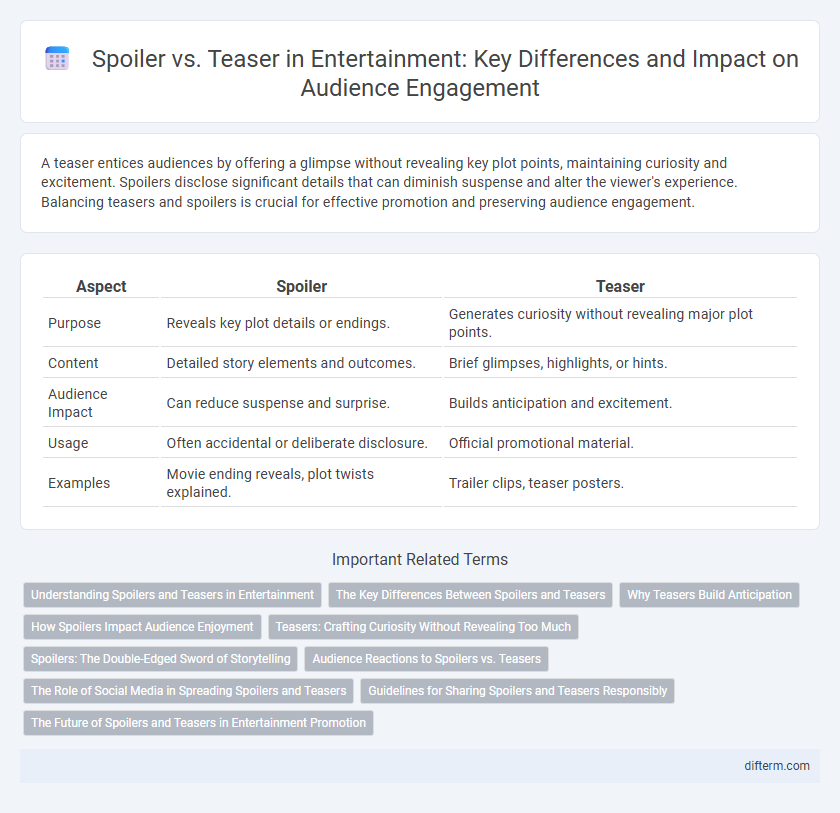A teaser entices audiences by offering a glimpse without revealing key plot points, maintaining curiosity and excitement. Spoilers disclose significant details that can diminish suspense and alter the viewer's experience. Balancing teasers and spoilers is crucial for effective promotion and preserving audience engagement.
Table of Comparison
| Aspect | Spoiler | Teaser |
|---|---|---|
| Purpose | Reveals key plot details or endings. | Generates curiosity without revealing major plot points. |
| Content | Detailed story elements and outcomes. | Brief glimpses, highlights, or hints. |
| Audience Impact | Can reduce suspense and surprise. | Builds anticipation and excitement. |
| Usage | Often accidental or deliberate disclosure. | Official promotional material. |
| Examples | Movie ending reveals, plot twists explained. | Trailer clips, teaser posters. |
Understanding Spoilers and Teasers in Entertainment
Spoilers reveal crucial plot details that can diminish suspense and viewer enjoyment, while teasers provide brief, tantalizing glimpses designed to generate excitement without disclosing key story elements. Effective marketing strategies in entertainment balance these tools to engage audiences, leveraging teasers to build anticipation and minimizing spoilers to preserve narrative surprise. Understanding the impact of spoilers and teasers helps creators maintain viewer interest and protect storytelling integrity.
The Key Differences Between Spoilers and Teasers
Spoilers reveal critical plot details that can diminish the audience's experience by removing suspense and surprise, while teasers strategically provide minimal information designed to intrigue and generate excitement. Spoilers often leak conclusions or twists, potentially harming viewer engagement, whereas teasers maintain mystery to build anticipation for upcoming movies, TV shows, or games. Effective teasers balance revealing just enough to captivate interest without giving away definitive story elements.
Why Teasers Build Anticipation
Teasers build anticipation by offering just enough excitement to spark curiosity without revealing critical plot points, creating a sense of mystery that engages the audience. They strategically highlight key elements such as characters, settings, or an intense moment, which strengthens emotional investment. This subtle approach increases viewer eagerness and encourages discussions, boosting overall interest before a full release.
How Spoilers Impact Audience Enjoyment
Spoilers often diminish audience enjoyment by revealing key plot points, reducing suspense and emotional impact. Teasers, by contrast, create intrigue without disclosing critical details, maintaining anticipation and engagement. Understanding the difference helps content creators balance excitement with preservation of the storytelling experience.
Teasers: Crafting Curiosity Without Revealing Too Much
Teasers in entertainment masterfully craft curiosity by presenting intriguing glimpses, engaging audiences without divulging key plot details or spoilers. These short previews use carefully selected visuals and sound snippets to build anticipation, sparking discussion while preserving suspense. Effective teasers balance revealing enough to entice viewers with maintaining narrative secrecy, ensuring excitement peaks at the official release.
Spoilers: The Double-Edged Sword of Storytelling
Spoilers reveal crucial plot details that can enhance or diminish the audience's emotional engagement, making them a double-edged sword in storytelling. While some viewers seek spoilers to anticipate key moments and reduce uncertainty, others argue that spoilers erode suspense and lessen the impact of narrative twists. Balancing the appeal of spoilers with preserving the integrity of a story remains a central challenge for creators and consumers in the entertainment industry.
Audience Reactions to Spoilers vs. Teasers
Spoilers often provoke strong negative reactions from audiences, as they reveal critical plot points and diminish the suspense and surprise of the narrative. Teasers generate curiosity and excitement by offering glimpses without disclosing key details, encouraging anticipation and active engagement. Audience preference generally leans toward teasers, which preserve the storytelling experience while building hype.
The Role of Social Media in Spreading Spoilers and Teasers
Social media platforms exponentially amplify the reach of spoilers and teasers, enabling rapid dissemination among global audiences. Algorithms prioritize engaging content, which often includes provocative spoilers or tantalizing teasers, increasing their visibility and impact. User-generated content and viral sharing further blur the lines, making it challenging for fans to avoid plot revelations or promotional sneak peeks.
Guidelines for Sharing Spoilers and Teasers Responsibly
Sharing spoilers and teasers responsibly requires clear labeling to respect audience preferences and prevent unintended plot revelations. Providing spoiler warnings or using spoiler tags allows viewers to choose when and how they consume content, maintaining narrative suspense. Teasers should intrigue without revealing critical plot points, preserving the storytelling experience while generating interest.
The Future of Spoilers and Teasers in Entertainment Promotion
Spoilers and teasers will continue evolving as essential marketing tools in entertainment promotion, leveraging advanced technologies like AI-generated previews and personalized content delivery. Interactive teasers providing immersive experiences, such as VR clips or augmented reality scenarios, are expected to heighten audience engagement while maintaining intrigue. Balancing the desire for suspense with growing fan demands for early information will shape future strategies for studios and streaming platforms.
spoiler vs teaser Infographic

 difterm.com
difterm.com